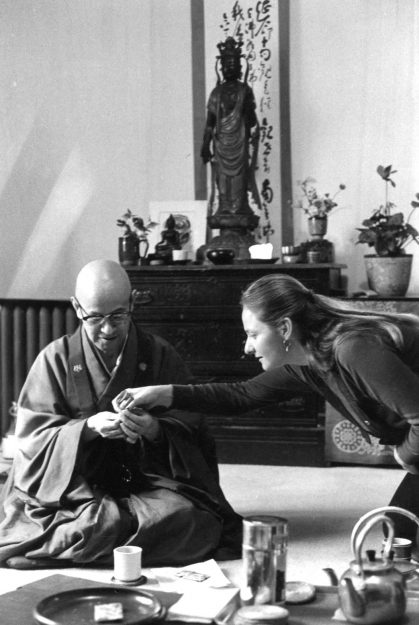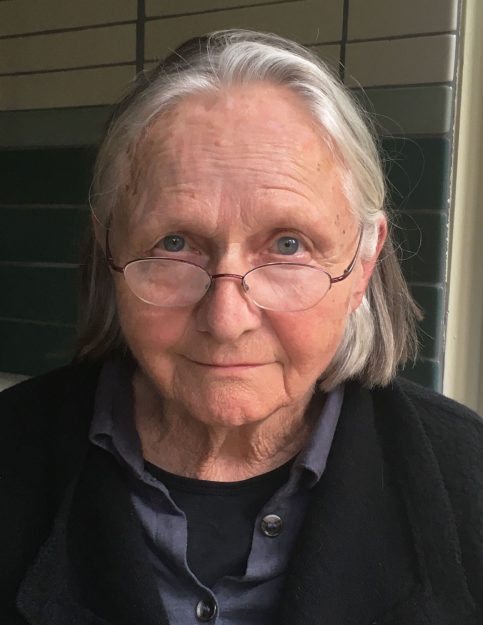no wind, yet the windbells
keep on ringing
—Kokan Shiren
Yvonne Rand (née Boye), a member of the first generation of American Zen teachers, died on August 19, 2020, shortly before her eighty-fifth birthday. Her life was as rich as it was long, and lived at full intensity. She brought to the world a wide range of gifts and a compassionate mind. An early and enduring dedication to horseback riding had taught Rand to be fluidly settled in her seat, mindful and aware in the moment. Rand’s ability to weave together so many strands of Buddhist teachings carried through her decades of teaching and echoed the diversity of her interests.

Born September 23, 1935 and raised in California, Rand graduated from Stanford University in 1957. She first turned her attention to Eastern religions during her college years, and began studying the teachings of the Buddha dharma in 1954, entering a Soto Zen path shortly after. She became a close student of Shunryu Suzuki Roshi in 1966, served as his secretary and personal assistant, and together with his wife Mitsu Suzuki, cared for him through his dying and death in 1971. After helping to found the San Francisco Zen Center (SFZC) in 1967, Rand was ordained as a priest there and served on the board of directors for many years, practicing and teaching primarily at Green Gulch Zen Center. She also studied with Dainin Katagiri Roshi and received dharma transmission from him in 1989.
Committed to rooting the dharma in Western soil, Rand renounced formal titles, such as roshi, the traditional term for a senior priest and teacher like herself.. She described herself as a lay householder priest, emphasizing the importance of the world of family and daily life in dharma practice.
Rand’s profound interest in the dharma led her to study with notable teachers in many Buddhist traditions, including Rinzai Zen roshis Maureen Stuart and Shodo Harada; Theravada Buddhist monks Ven. Henepola Gunaratana and Ajahn Sumedho; as well as His Holiness the 14th Dalai Lama and Tibetan teacher Tara Tulku Rinpoche. Her work with Tara Tulku Rinpoche led to her active support of the Tibetan Buddhist community in diaspora and to a recognition of the deep connections between Vajrayana Buddhism and Soto Zen insights and practices.
Rand’s spiritual interests expanded beyond the Buddhist tradition. From 1970, she studied with Harry Kellett Roberts, a widely recognized California native-plant specialist trained in the Native American tradition of the Yurok People, who also lived with Rand’s family in the last several years of his life.
In Marin County, California, Rand established a Buddhist practice center with a focus on Zen and taught there for many years; she named it Goat-in-the-Road, named for a time she tried to save young goats destined for an Easter auction—so typical of her vivid sense of humor and her generosity. In 2005 she moved Goat-in-the-Road (also known as Bodaiji, Buddha Mind Temple) to Philo, Mendocino County, where she continued to teach and to lead retreats.
An environmental activist and leader, she served on the early board of The Trust for Public Land from 1974 to 1984, and spent the last five years as board chair, working closely with environmentalist and the Trust’s founder Huey Johnson. Her environmental activism extended into her Buddhist practice. An avid gardener, she brought plants, animals, clouds, and water into her teachings. Her creative explorations were wide-ranging, rooted in her long training in weaving and ceramics. Among the directions her creativity took were studies in Noh theater chanting and tea ceremony with Yaeko Nakamura Sensei, and the formation and study of an extensive collection of Tibetan Buddhist art. She was centrally involved in a research program called AWAKE: Art, Buddhism, and the Dimensions of Consciousness.
Rand’s teaching style emphasized “portable” real-life practices and focused observation: “You can’t change what you don’t notice,” she declared. She stressed focusing on speech as a window to the mind. Reflecting on the impact that one’s speech has on others, helps one be clear and accountable for everything one says, and for, as she said, “studying conditioned mind in service of dismantling conditioned patterns.” And while her commitment to embodying Zen practice was dedicated and intense, she also taught the importance of rest and ease, saying, “One does not enter the field of wisdom unless there is the deeply developed capacity for ease.”
Rand was instrumental in developing a ceremony of remembrance in the West, called the Jizo Ceremony (after the Japanese bodhisattva) for children, born and unborn, who have died. Her understanding of the inseparability of life and death led her to sit with and tend people in end-of-life care over many decades, with the same attentiveness she brought to all her encounters. She also taught and counseled extensively both professional and volunteer caregivers working with the terminally ill.
Yvonne Rand was married for four decades to William Wallace Sterling, who predeceased her by nine months. Bill was an attorney, a classics scholar, an amateur ornithologist and botanist, and a Buddhist practitioner. He served on the board of Tibet House in New York and on the board of the International Committee of Lawyers for Tibet. Together with Bill, Yvonne founded the Callipeplon Society, a nonprofit organization created initially to provide support to Lama Anagarika Govinda and his wife Li Gotami. The Society later centered its efforts on widening the understanding of Buddhism in the US and on adapting traditional Buddhist teachings for the lives of lay practitioners.

Rand leaves two children, Christopher and Hilary Rand; Christopher’s wife Francesca Stauffacher and her daughter Isabella Bertaud; Hilary’s partner, Helen Berggruen; and Bill’s two children, Alinor and Maury Sterling. An earlier marriage to Kendrick Rand, father of her two children, ended in divorce in 1968. She also leaves many devoted students and friends, and a legacy of abiding connection with them. She was a teacher, friend, and mother who looked so openly and closely at the people in her life that they felt most deeply seen.
In her last years, she gradually became ill with Alzheimer’s disease. She was open about her progressive condition and was able to continue teaching, not despite but with it, taking it into account. As her losses became more apparent, a student noted that she had never witnessed Rand reacting with frustration or self-criticism to her diminishing capabilities. When asked about this, even with advanced Alzheimer’s, Rand observed with clarity, “I am in the moment as it arises.”
The day before she died, she said, “No form—we just say thank you.” A strong and fearless explorer, Yvonne had unwavering curiosity and force of spirit and a steady onrush of vitality and passion. There was no drawdown of this tide. The depth of her teaching continues beyond her lifetime.
♦
Contributions in Yvonne Rand’s memory may be made to The Callipeplon Society, 645 J Street, Davis, CA 95616, or to The Trust for Public Land, P.O. Box 399336, San Francisco, CA 94139. Both are 501(c)(3) tax-exempt organizations. A memorial service will be held once it becomes safe to congregate.